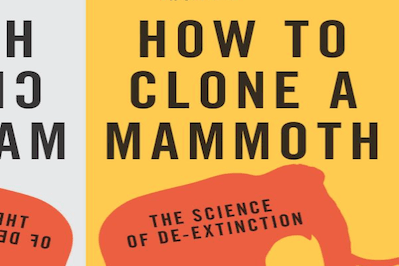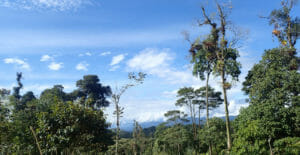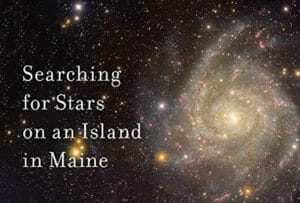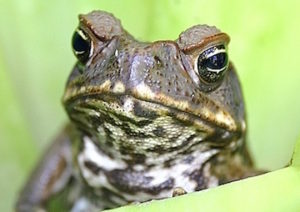How to Clone a Mammoth
If we could bring back extinct species, should we? This is one of the questions explored by Beth Shapiro, an evolutionary biologist who takes the fantastic to a higher level with her new book, "How to Clone a Mammoth: The Science of De-Extinction." Princeton University Press
Princeton University Press
Princeton University Press
“How to Clone a Mammoth: The Science of De-Extinction” A book by Beth Shapiro
Last summer, the Center for Biological Diversity filed a petition with the U.S. Fish and Wildlife Service requesting that the grizzly bear, which is today found mostly in Alaska and Yellowstone National Park, be reintroduced into regions where it once thrived. Among the habitats proposed by the environmental organization was California’s Sierra Nevada. The last grizzly in California was spotted in 1924, and the effort to return the animal, which is emblazoned on the state flag, elicited both excitement and fear. But mostly fear. A charging ursus arctos horribilis can reach speeds of 30 miles an hour. It weighs up to 1,700 pounds. One resident of the Sierras, informed of the proposal by a reporter, put her hand to her mouth in shock. Another said that reintroducing the grizzly “would be like bringing back Tyrannosaurus rex.” After I read about the petition in the newspaper, the potential return of the grizzly stuck in my head for weeks, in part because it seemed so fantastical. Could we really bring back such large animals and set them loose in a land they hadn’t known for nearly a century? And if we did, what would happen?
These are the sorts of questions that consume Beth Shapiro, an evolutionary biologist who takes the fantastic to a higher level with her new book, “How to Clone a Mammoth: The Science of De-Extinction.” Shapiro, an expert in “ancient DNA,” won a MacArthur Award in 2009 at the age of 33, and she and a band of pioneering scientists have been on a mission to “de-extinct” animals, a project that she argues has “great potential” in the fight to conserve existing species and habitats.
What does it mean to “de-extinct” a species? Notwithstanding the book’s title, it won’t usually involve cloning, at least for animals like the mammoth that died out thousands of years ago. (To clone an animal, a living cell is needed.) Instead, Shapiro spends her time studying ancient mammoth bones, mapping the genomes of the animal to compare it to its nearest living relative, the Asian elephant. In time, scientists like Shapiro hope to identify which DNA sequences can be tweaked to give mammoth-like characteristics to elephants — such as the ability to withstand cold temperatures — and, one day in the not too distant future, implant a mammoth-like embryo into a female elephant. In northwest Siberia, where large herbivores once feasted on the tundra grassland, a researcher has already established a nature reserve, Pleistocene Park, waiting for the first mammoths to arrive.
Shapiro’s primary goal, she writes, is to explain de-extinction “in a way that separates science from science fiction.” She criticizes the tendency of some journalists to sensationalize or mischaracterize de-extinction, and explains the current state of research in clear language that is accessible to a nonscientist. She is also forthright regarding the challenges in the work. Shapiro describes a trip taken to Siberia where, after days of searching for mammoth bones and combating ferocious mosquitoes, she returns mostly empty-handed. And when she does find mammoth bones — even well preserved bones — the DNA that is recovered is fragmentary. Almost always, it is contaminated with the DNA of plants and other animals. Making the project more difficult, the genome of the Asian elephant isn’t entirely known. “In essence, we have billions of microscopic, slightly misshapen puzzle pieces and a slightly blurry photographic key that solves a different puzzle,” Shapiro writes.
But the scientists will eventually succeed. In March, Harvard geneticist George Church, who figures prominently in Shapiro’s book, announced that his lab had spliced mammoth genes into the genome of an Asian elephant. It was, noted Popular Science, “the first time woolly mammoth genes have been functional since the species went extinct.” The future isn’t quite now, but it’s pretty soon.
That an animal can be brought back is not an argument that an animal should be brought back. Shapiro notes, early in the book, “that the present focus on bringing back particular species — whether that means mammoths, dodos, passenger pigeons, or anything else — is misguided.” She sees the de-extinction project along similar lines as the rewilding movement, which seeks to restore lost ecosystems by reintroducing animals and plants to areas in which they once thrived. “We should think of de-extinction not in terms of which life form we will bring back, but what ecological interactions we would like to see restored,” she writes.
What possible good comes from bringing the mammoth back to Siberia? Mammoths once transported seeds and nutrients across the tundra, and their presence may help the land revert to rich grasslands; these grasslands could then support the return of endangered species such as the Siberian tiger. Research has also shown that returning large herbivores to the tundra may slow the rate of global warming. In Siberia, accumulated snow creates an insulation layer that shields the ground from frigid air temperatures. Trapped in this soil is twice the amount of carbon that is in the Earth’s atmosphere. As the soil warms, partly due to the insulating snow, carbon is released. But in Pleistocene Park, where imported deer, bison and horses disturb the snow, the soil, which is directly exposed to the air, is much colder. This colder ground releases less carbon. With mammoths trampling snow, the theory goes, even more carbon would stay out of the atmosphere.
This potentially happy outcome follows several of Shapiro’s thoughtful guidelines for deciding when it makes sense to de-extinct a species. First: Is there a place to put the species in the wild where it can survive and thrive? And will it play a restorative role in the ecosystem? Those kinds of considerations, however, are ones that the market will easily overlook. Shapiro is repulsed by the thought of bringing back species only to have the miserable creatures stuck in a zoo and gawked at while cameras flash. But if de-extinction proceeds, that will certainly happen.She acknowledges that money is already driving much of the work. Along with mammoths, she does research that aims to bring back the passenger pigeon. Using Shapiro’s own criteria, passenger pigeons are terrible candidates for de-extinction. Many of the forests they depended upon have disappeared. They traveled in massive flocks — one observer reported a group of 3.5 billion birds blackening the sky — that wouldn’t be welcome in today’s neighborhoods. But influential people are fascinated by passenger pigeons, and funding is available, so the work proceeds.
Writing about the effort to bring back the passenger pigeon in The New Yorker, Elizabeth Kolbert described de-extinction as “a vanity project and nothing else.” (Kolbert has warmer words for Shapiro, contributing a blurb for the book.) Shapiro considers herself an “enthusiastic realist,” and sees de-extinction as an important tool in the fight for conservation. But when one looks at the difficulty and uncertainty involved in the attempt to resurrect lost species, and balances the potential benefits with the costs, it is hard not to share Kolbert’s skepticism. In time, de-extinction projects will likely suck up money that would have gone to conservation, and animals like the Asian elephant — an extremely sensitive and already endangered creature — will likely be harmed when asked to carry a foreign species in their womb. Yes, global warming may be lessened to some small extent when mammoths disturb snow in Siberia. But this has to be one of the most complicated ways to fight climate change.
“How to Clone a Mammoth” was my introduction to de-extinction. I began the book intrigued. By the time I reached the final chapter, in which Shapiro asks whether we should proceed with de-extinction, I was something less than an enthusiastic realist. Proponents of de-extinction seem to be captivated by the prospect that extinct animals can be resurrected in some form, and then have gone searching for arguments to justify this pursuit. Not that there aren’t arguments to muster; there certainly are. But many, like eliciting the mammoth in the fight against climate change, aren’t especially persuasive.
In the final chapter, Shapiro — who does an admirably fair job presenting critiques of de-extinction — writes that she is excited by her work in part because it “uses awesome, exciting, cutting-edge technology to take a giant step forward,” which “allows us to actively create a future that is really better than today, not just one that is less bad than what we anticipate.” Although Shapiro comes across as eminently trustworthy and clearheaded, this is the sort of triumphant language that usually gets us in trouble. There is no proof that de-extinction will do what she promises, at least not yet. But there is also no stopping de-extinction, and so I certainly hope every word turns out to be true.
Gabriel Thompson has written for The New York Times, New York, The Nation and Mother Jones. His most recent book is “Working in the Shadows: A Year of Doing the Jobs (Most) Americans Won’t Do.”
Your support matters…Independent journalism is under threat and overshadowed by heavily funded mainstream media.
You can help level the playing field. Become a member.
Your tax-deductible contribution keeps us digging beneath the headlines to give you thought-provoking, investigative reporting and analysis that unearths what's really happening- without compromise.
Give today to support our courageous, independent journalists.






You need to be a supporter to comment.
There are currently no responses to this article.
Be the first to respond.